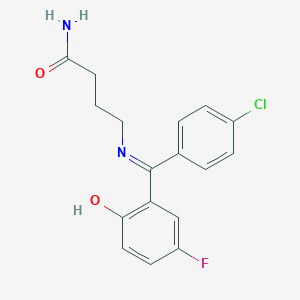Drug Information
| Drug General Information | |||||
|---|---|---|---|---|---|
| Drug ID |
D0O5LA
|
||||
| Former ID |
DAP000258
|
||||
| Drug Name |
Progabide
|
||||
| Synonyms |
Gabren; Gabrene; Halogabide; Progabida; Progabidum; SL 76002; Gabren (TN); Gabrene (TN); Progabida [INN-Spanish]; Progabidum [INN-Latin]; SL 76-002; SL-76002; Progabide (USAN/INN); Progabide [USAN:BAN:INN]; Progabide [USAN:INN:BAN]; 4-(((4-Chlorophenyl)(5-fluoro-2-hydroxyphenyl)methylene)amino)butanamide; 4-((alpha-(p-Chlorophenyl)-5-fluorosalicylidene)amino)butyramide; 4-(alpha-(p-Chlorophenyl)-5-fluoro-2-hydroxybenzylideneamino)butyramide; 4-[[(4-chlorophenyl)-(3-fluoro-6-oxocyclohexa-2,4-dien-1-ylidene)methyl]amino]butanamide; 4-[[(E)-(4-chlorophenyl)-(3-fluoro-6-oxocyclohexa-2,4-dien-1-ylidene)methyl]amino]butanamide; 4-[[(Z)-(4-chlorophenyl)-(3-fluoro-6-oxocyclohexa-2,4-dien-1-ylidene)methyl]amino]butanamide
|
||||
| Drug Type |
Small molecular drug
|
||||
| Indication | Depression [ICD9: 311; ICD10:F30-F39] | Approved | [536361] | ||
| Therapeutic Class |
Antidepressants
|
||||
| Company |
Sanofi-Aventis
|
||||
| Structure |

|
Download2D MOL |
|||
| Formula |
C17H16ClFN2O2
|
||||
| Canonical SMILES |
C1=CC(=CC=C1C(=C2C=C(C=CC2=O)F)NCCCC(=O)N)Cl
|
||||
| InChI |
1S/C17H16ClFN2O2/c18-12-5-3-11(4-6-12)17(21-9-1-2-16(20)23)14-10-13(19)7-8-15(14)22/h3-8,10,21H,1-2,9H2,(H2,20,23)/b17-14+
|
||||
| InChIKey |
DWEQWXSKOHHBNT-SAPNQHFASA-N
|
||||
| CAS Number |
CAS 62666-20-0
|
||||
| PubChem Compound ID | |||||
| PubChem Substance ID | |||||
| SuperDrug ATC ID |
N03AG05
|
||||
| SuperDrug CAS ID |
cas=062666200
|
||||
| Target and Pathway | |||||
| Target(s) | Gamma-aminobutyric acid B receptor | Target Info | Agonist | [537721], [537874], [538077] | |
| References | |||||
| Ref 537721 | Suppression by progabide of ethanol withdrawal syndrome in rats. Eur J Pharmacol. 1985 Mar 12;109(3):321-5. | ||||
| Ref 537874 | Pentobarbital-like discriminative stimulus effects of direct GABA agonists in rats. Psychopharmacology (Berl). 1993;110(3):295-301. | ||||
| Ref 538077 | Interactions between dopamine and GABA in the control of ambulatory activity and neophobia in the mouse. Pharmacol Biochem Behav. 1998 Jan;59(1):239-47. | ||||
If You Find Any Error in Data or Bug in Web Service, Please Kindly Report It to Dr. Zhou and Dr. Zhang.

